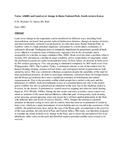Evaluation of the Economic Net Benefits of the various fields found on a smallholder farming system in Vihiga-Kenya
Strong gradients of decreasing soil fertility are found with increasing distance from the homestead within smallholder farms in Vihiga-Kenya. Nutrient use efficiency varies strongly between fields along these gradients of soil fertility. There is continuous accumulation of nutrients in areas around the homestead at the expense of nutrient depletion in further and larger fields. Unequal distribution of nutrients on the farm causes differences in yield with more yields being obtained in some areas on the farm than others.









